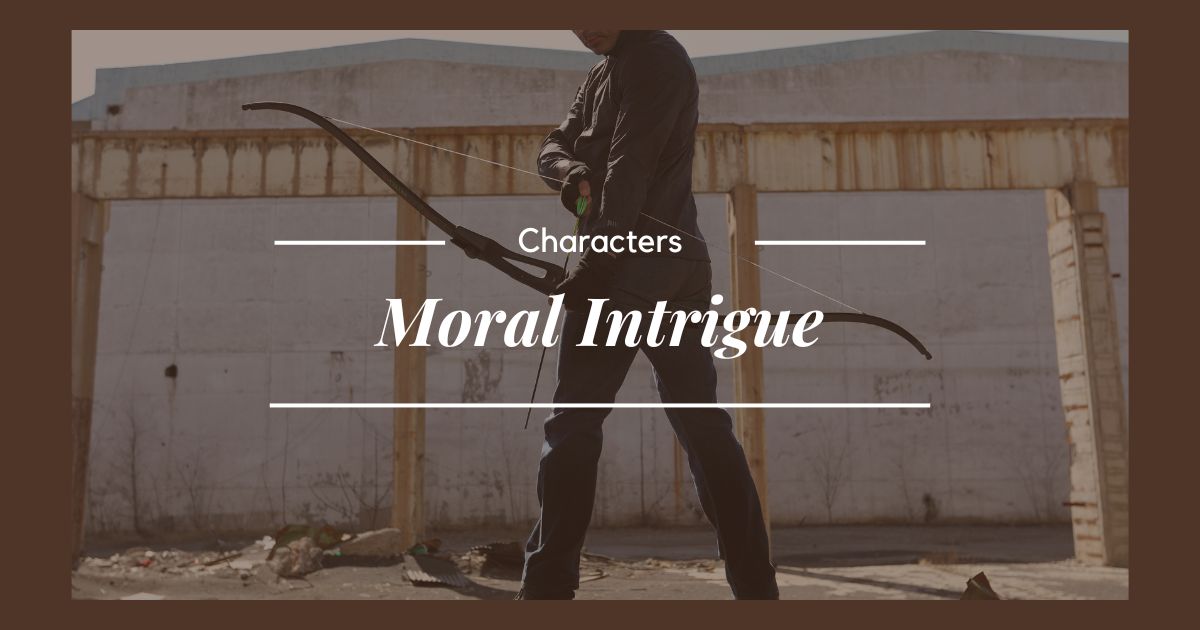Last week, I talked about the problems I had with overly moralistic literature. So it only seemed fair to follow up with the pros and cons of the flipside of that coin: stories with morally gray characters.
In the vast realm of literature, characters come in all shades of morality. Some wear the white hats of virtue, while others are draped in the dark cloaks of malevolence. And then, there are those intriguing individuals who reside in the murky middle, the morally ambiguous characters.
These characters draw in readers and writers alike – but not all narratives with these mysterious figures stick the landing. Let’s talk about it.
What makes a character morally gray?
Morally gray characters are neither purely good nor irredeemably evil. They occupy a moral spectrum where their actions and intentions are a perplexing blend of virtue and vice. These characters often challenge readers’ preconceived notions of right and wrong, forcing us to grapple with the ambiguity of human nature.
Morally gray characters are versatile, seamlessly blending into various genres. In mysteries, they make brilliant detectives with their unconventional methods. In fantasy, they could be cunning antiheroes navigating treacherous worlds. In thrillers, their ambiguity adds layers of suspense. And in romance novels, they bring a unique flavor to the classic love story.
Depending on the story, the morally gray character can be the vicious murderer who only hunts the wicked, or the queen who advocates for the good of the people while also ruthlessly eliminating competition. It’s the villain who balks at hurting loved ones but easily throws others under the bus to save their own skin. It can even be the love interest who is willing to burn down the world for their beloved.
You know you have a morally gray character on their hands when, from scene to scene, you can’t tell if they’re actually the good guy or the bad guy.
These characters are alluring.
Why do readers and writers gravitate toward morally gray characters? The answer lies in their complexity.
Morally gray characters are like intricate puzzles waiting to be solved. They captivate our imaginations because they defy easy categorization, keeping us engaged and guessing. They reflect the duality of real-life personalities, making them more relatable and thought-provoking.
Some books pull this off, others don’t.
The use of morally gray characters in literature offers a range of strengths, each contributing to the complexity and depth of the narrative. For example:
- Complex character development. Their internal struggles, conflicts, and moral ambiguity allow authors to explore various facets of the characters’ personalities, adding depth.
- Emotional engagement. The uncertainty surrounding their actions and intentions creates a sense of unpredictability, making the audience more invested in the story. Readers find themselves empathizing with, or even rooting for, characters whose choices they might not wholly endorse.
- Moral reflection. Morally gray characters blur the lines between right and wrong, prompting discussions about the shades of gray that exist in real life.
- Avoiding clichés. Morally gray characters can offer fresh perspectives and narratives that stand out in a crowded literary landscape of well-worn tropes and archetypes.
But not every morally gray character succeeds in winning over the audience. These stories can have a few weaknesses:
- Potential for confusion. Readers might struggle to understand their motivations and actions, which could result in a lack of connection with the character.
- Risk of underdeveloped backstories. Morally gray characters often have intriguing backstories and hidden motivations. However, if not handled with care, their complexity can lead to underdeveloped or overly enigmatic character histories. It’s crucial for writers to provide sufficient context to help readers understand and empathize with these characters.
- Generic use of the “tragic backstory” isn’t enough on its own.
- Challenging endings. Striking the right balance between redemption, ambiguity, and resolution can prove difficult with characters who may need to be served justice themselves.
But we have to talk specifically about morally gray love interests in romance novels for a sec.
In the world of romance novels, morally gray characters take on an especially intriguing role. They subvert the traditional “good guy meets good girl” trope, often injecting some much-needed tension and unpredictability into the story. These characters usually come with a dark past or hidden flaws, making the romantic journey one of redemption and transformation.
Yet, it’s essential to recognize that the term “morally gray” in romance is often used to describe characters who are, at heart, good but appear otherwise. It’s not about characters who are genuinely morally ambiguous, blurring the lines between right and wrong.
In the romance genre, everything is filtered through rose-colored glasses. That’s not a bad thing, it’s just how these stories operate. You can’t have the concepts of true love or soulmates in a story based too much in (decidedly less romantic) reality. These stories romanticize their content.
That being said, there’s a thin line between acceptable moral grayness and romanticizing abuse or bad behavior. There are things you may find exciting in a romance novel that should absolutely have you calling the police if it happened in real life. Let’s be real.
If you find yourself frequently taken with “bad boy” types in romance novels and think they’d be just as exciting in real life: Jenna Moreci has an excellent YouTube video about writing healthy romances, and I recommend it to both readers and writers. It hits the nail on the head about consent, equality, respect, fighting, communication, and happiness.
I say all this as someone who also enjoys these characters, but is IRL married to a golden retriever husband.
Morally gray characters are here to stay for now.
While they aren’t without their challenges, the presence of morally gray characters in various genres, including romance, keeps stories fresh and engaging.
Whether as detectives solving mysteries or star-crossed lovers walking the fine line between good and bad, morally gray characters continue to captivate our literary imaginations, challenging our perceptions of morality and character.
I don’t predict their popularity waning any time soon.
If you liked this blog, please consider subscribing! I don’t yet have a newsletter or anything fancy (I’m a one-woman show and I do this for fun), but if you subscribe you’ll get an automated email notification like this on Tuesdays and Thursdays at 11:30am Central time when I post a new blog:

I would love to have you around! Subscribe below.
Check out some of my other recent blogs:









2 responses to “Gray Area: Morally gray characters and you”
It’s especially fascinating when a character transitions to morally gray because of some larger plot development, and MC must discover the cause as a means of enlightenment. There’s a character like that in my current read (Atlas Shrugged)
Yes, I love watching characters have to choose to do something bad to achieve good ends, it leads to so much delicious angst and turmoil!